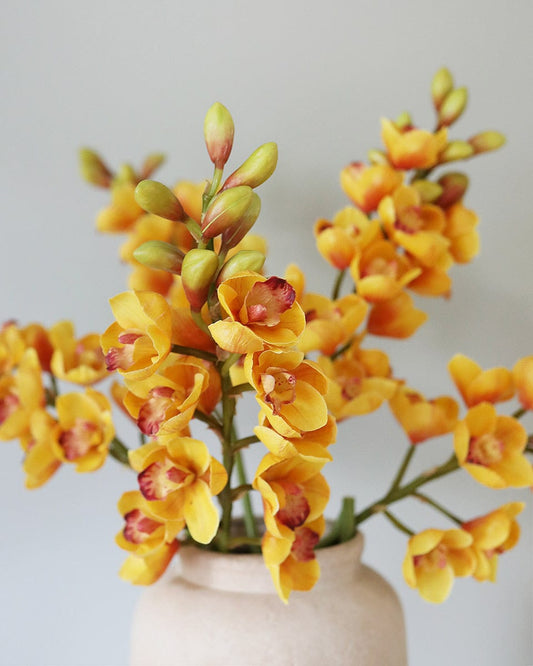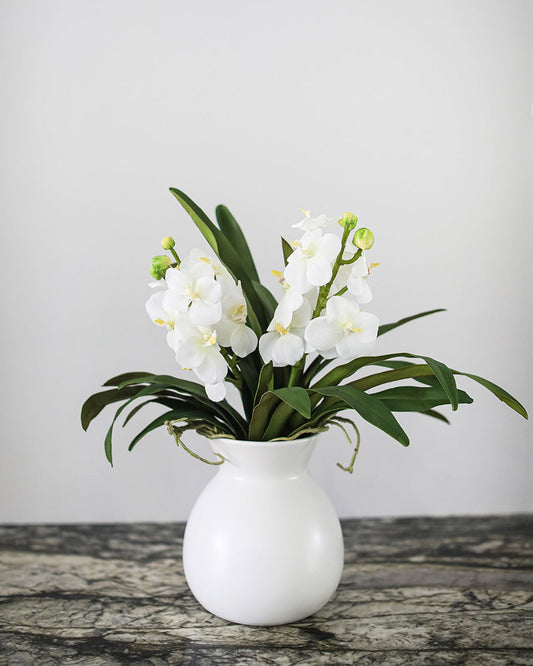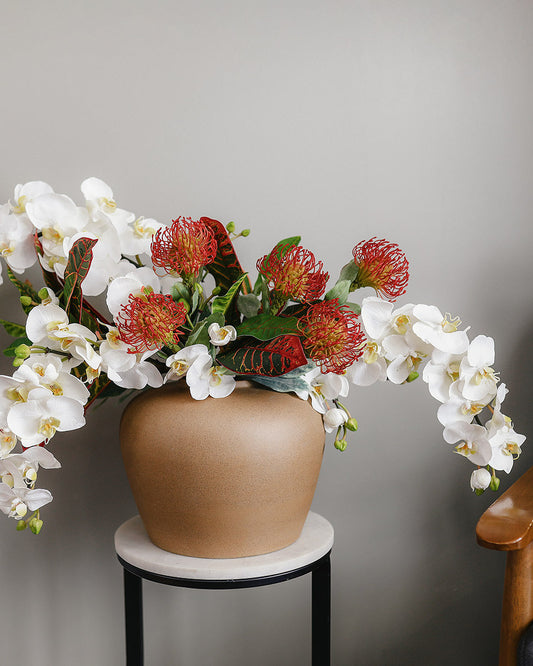2025 Color Trends: Beautiful Artificial Orchid Shades You’ll Love

I was rearranging my room last week when the afternoon light caught these new orchid stems I'd been working with—suddenly, the subtle color variations that had been barely noticeable under fluorescent lighting absolutely came alive. That moment reminded me why I'm so fascinated by how artificial orchid colors have evolved over the past few years. We're seeing some truly stunning developments in color technology that make these permanent botanicals more captivating than ever.
The world of fake orchids has transformed dramatically, especially in terms of color sophistication and depth. What I find particularly exciting is how manufacturers are now capturing those delicate color transitions that make real orchids so mesmerizing—the way a deep magenta might fade to pale pink at the petal edges, or how white blooms can have the faintest hint of green at their base.
Key Takeaways
- Rich magenta and deep pink orchids are dominating current design trends
- Soft coral and peach tones offer warmth without overwhelming neutral spaces
- Classic white remains versatile with improved translucency techniques
- Multi-tonal and spotted varieties create visual interest and authenticity
- Color-gradation technology now mimics natural petal variations beautifully
The Rise of Rich Magenta and Deep Pink Tones
There's something absolutely magnetic about deep magenta orchids right now. I've been working with these intense pink-to-purple hues for several installations lately, and they never fail to create that perfect dramatic focal point. What I love most about this trend is how these bold colors translate beautifully in both traditional and contemporary settings.
These deeper pink tones—or should I say fuchsia? I sometimes debate the exact terminology—work exceptionally well because they bridge the gap between feminine softness and sophisticated drama. In my experience, a single stem of deep magenta orchid can transform an entire room's energy. The color has enough intensity to stand alone as a statement piece, yet it's surprisingly versatile when paired with neutrals or even other bold hues.
What makes this particular orchid so striking is the depth of its color saturation. The rich magenta blooms create an immediate sense of luxury and sophistication that works beautifully in modern interiors. I often recommend placing these in spaces where you want to create visual weight—like anchoring a console table or adding drama to a minimalist bookshelf.
Embracing Soft Coral and Peachy Pink Variations
While bold magentas command attention, there's an equally compelling trend toward softer, warmer pink tones. These coral and peach-influenced orchids—actually, is it more peachy coral or coral peach? I find myself constantly refining these color descriptions—offer a gentler approach to incorporating color into your space.
What I've discovered through my work is that these warmer pink tones have an incredible ability to make spaces feel more inviting without overwhelming the existing color palette. They work particularly well in spaces with natural wood elements or warm metallics, creating a harmonious flow that feels both contemporary and timeless.
The spotted pattern on this orchid adds an element of playfulness that I absolutely adore. It's sophisticated enough for formal settings yet has that touch of whimsy that makes it perfect for more casual spaces. The combination of white base with pink spots creates visual interest without being overwhelming.
The Enduring Appeal of Classic White Orchids
Despite all the exciting color developments, white orchids remain a cornerstone of artificial orchid collections—and for good reason. What's changed is the sophistication of how white is now rendered in realistic artificial orchids. The new translucency techniques create depth and dimension that makes these blooms appear almost luminous.
I've been particularly impressed with how modern white orchids capture those subtle undertones that make natural white orchids so compelling. There might be the faintest hint of green at the base, or a cream undertone that adds warmth to the overall appearance. These details make all the difference in creating arrangements that feel authentic and sophisticated.
The cascading nature of this white orchid creates such elegant movement in arrangements. I love how the multiple blooms on each stem provide fullness while maintaining that graceful, naturally flowing appearance that makes orchids so distinctive.
Creating Sophisticated Color Combinations
One of the most exciting aspects of working with today's artificial orchids is the ability to create sophisticated color combinations that would be difficult to achieve with live plants. I often combine different tones within the same color family—perhaps pairing deep magenta with softer pink spotted varieties, or mixing classic white with faux orchids that have subtle peachy undertones.
What I've learned is that the key to successful color combinations lies in understanding undertones. Even within what appears to be a single color category, there are warm and cool variations that can either harmonize beautifully or create unwanted tension. The spotted varieties are particularly useful for bridging different solid colors, as they naturally contain multiple tones within a single bloom.
For larger installations, I often create gradual color transitions—starting with deep magenta, moving through various pink tones, and ending with white. This creates a sophisticated ombré effect that feels both natural and intentionally designed. The beauty of working with artificial orchids is that you can maintain these color relationships permanently, without worrying about blooming cycles or seasonal availability.
The versatility of modern artificial orchids means you can experiment with color combinations that reflect current trends while creating something uniquely your own. Whether you're drawn to the drama of deep magentas, the warmth of coral tones, or the timeless elegance of white, there's never been a better time to explore the sophisticated world of artificial orchid flowers.
Bringing Trending Orchid Colors Home
Working with trending orchid colors has taught me that the most successful arrangements often start with understanding your space's existing color story. These new color developments in artificial orchids give us incredible flexibility to either complement what's already there or create a bold new direction entirely.
I encourage you to think beyond traditional single-color arrangements. The spotted varieties, in particular, offer wonderful opportunities to tie together multiple elements in a room. A pink and white spotted orchid can bridge warm wood tones with cool marble surfaces, or connect soft textiles with harder architectural elements.
Now that you know which colors are trending, it's time to incorporate trending colors into your decor with creative styling techniques that make the most of these beautiful hues.
Frequently Asked Questions
What orchid colors are most popular right now?
Deep magenta and rich pink tones are currently dominating design trends, followed by soft coral and peachy pink variations. Classic white remains timelessly popular, especially with improved translucency techniques that create more realistic depth.
How do I choose orchid colors for my home?
Consider your existing color palette and the mood you want to create. Deep magentas add drama and sophistication, coral tones bring warmth, and white provides versatile elegance. Spotted varieties are excellent for bridging multiple colors in your space.
Can I mix different orchid colors in one arrangement?
Absolutely! Mixing colors within the same family creates beautiful gradients, while spotted varieties naturally bridge different solid colors. The key is understanding undertones—warm pinks work well together, as do cool-toned varieties.
Do artificial orchid colors fade over time?
High-quality artificial orchids use UV-resistant pigments that maintain their color for years. However, direct sunlight can eventually cause fading, so it's best to place them in bright, indirect light for optimal longevity.
Shop the trend with our 2025-ready orchid collection featuring all the colors and styles you need to stay ahead of the curve.
🌿 Elevate Your Space with Beautiful Faux Orchids!
You've seen what you can do with our faux orchids, why not explore our stunning collection and try to create your very own artificial orchid arrangement?
Shop Our Artificial Orchids Here















